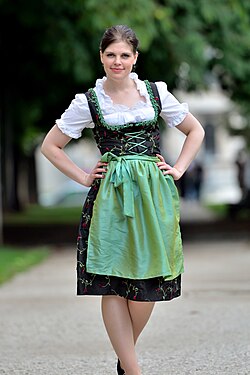Dirndl
A dirndl [ˈdɪʁndl̩] is a type of dress worn by women in Germany, Switzerland, Liechtenstein, Austria and South Tyrol. It is made to look like the traditional clothing that peasants from the Alps used to wear.[1] Originally the term Dirndl meant girl in Bavarian. Now it can mean either the dress or a girl.[2] It was also called a Dirndlgewand.[2] In the 1800s servant girls wore a very similar dress. They were very plain. A heavy, often dark colored dress was worn in winter. It had a long sleeve dirndl blouse and thick apron to go with it. In summer a light version was worn.[2] Summer dresses were worn with a short puffed-sleeve dirndl blouse. Different styles were worn in different regions.[3] The bow on the apron is tied on the left (she is single) or the right side (she is not single).[4]
Dirndl Media
Children wearing traditional dirndls at a folk festival in Vilshofen an der Donau (Bavaria), 2012
Women wearing the traditional blue dirndl from the Wachau region of Austria
Painting by Carl Spitzweg (1808–1885), Dirndl und Jäger im Gebirge (Young woman and hunter in the mountains), 1870
Painting by Hermann Kauffmann (1808–1889), Tändelndes Paar beim Buttern in der Stube (Couple courting while churning butter)
References
- ↑ Ethnic Dress in the United States: A Cultural Encyclopedia, eds. Annette Lynch; Mitchell D. Strauss (Lanham, MD: Rowman & Littlefield, 2015), p. 100
- ↑ 2.0 2.1 2.2 "German Dirndl". Stuart Anderson at www.destination-munich.com. Retrieved 27 April 2015.
- ↑ "Dirndl Basics". Austrian Tourism Board. Archived from the original on 12 April 2015. Retrieved 27 April 2015.
- ↑ "Dirndl knot on the left, in the centre or on the right?". bavarian-specialities.net. Retrieved 27 April 2015.[dead link]
| Wikimedia Commons has media related to Lua error in Module:Commons_link at line 62: attempt to index field 'wikibase' (a nil value).. |
Other websites
- Oktoberfest Dirndl Dress: The Bow Archived 2015-02-16 at the Wayback Machine
- How to wear a dirndl Archived 2015-02-15 at the Wayback Machine










